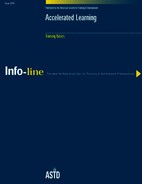Mind Operation Models
Lozanov's success can be traced to the way the brain operates. There are several theories to explain why adding music or other sensory stimulation increases the retention of learning.
Triune Brain Model
The triune model of how the brain processes information divides it into three layers, one superimposed upon the next. The three layers are:
Reptilian Brain or Brain Stem
This handles most sensory input and is connected to the higher-level functions. This portion of the brain evolved more than 500 million years ago.
Mammalian or Limbic System
This handles basic physical needs, such as breathing, eating, and heart rate. This portion of the brain also regulates emotional stability and the transfer of sensory input into memory. It evolved between 200 and 300 million years ago.
Cortex or “Human” Brain
This evolved about 50 million years ago and is our “thinking cap.” The cortex is the home of functions that make people “human,” that is, thinking, decision making, perceiving time, organizing sensory inputs, speaking, remembering, and learning new methods of coping, adopting, and adapting.
Stress and fear directly influence the limbic system. Studies have shown that the limbic system helps to maintain the emotional balance between rage and fear, pleasure and pain, expectation and actuality, and governs the fight or flight response. The limbic system also has been shown to play an important role in initial learning and short-term memory—which works just long enough for the conscious mind to grasp the information, after which it may be held in peripheral memory for no longer than a minute. Current theory states the average individual can hold only seven bits of information in short-term memory.
For information to be remembered, it needs to be reinforced. Reinforcement may take many forms, such as mnemonics and repetition, but a conscious effort must be made for the information to be stored in long-term memory. Memories are integrated—and may be held—in the limbic system. For learning to be effective, therefore, it must involve the limbic system.
Right Brain, Left Brain Model
Another popular theory is the right brain-left brain approach. This model asserts that the different sides of the brain handle different types of input. Generally, the left side of the brain is logical, systematic, linear, verbal, and judgmental, while the right side is creative, intuitive, holistic, visual, and playful. The specialized functions of the left side of the brain include:
time orientation
sequential processing of events
language skills
logic
mathematics
analysis
awareness of cause and effect
Specialized functions of the right side of the brain include:
emotion
intuition
visuo-spatial orientation
music
art, imagery, and pattern awareness
synthesis of information
simultaneous processing of events
timelessness
divergent thinking
Although the two hemispheres of the brain process information differently, they are complementary rather than competitive. For example, problem solving taps into both sides: The left side analyzes the problem, while the right develops alternative solutions to it. To make a decision, the left brain compares the solutions to the initial problem, while the right brain evaluates the solutions in terms of the overall situation.
While much training is targeted to the left brain (and is associated with rote practice and struggle), the right brain can “absorb large amounts of information with little effort,” notes Frank Clement, an AL consultant in Boulder, Colorado. “A major task of accelerated learning,” Clement adds, “is to orchestrate learning so that the right brain is appropriately engaged in cooperation with the left brain.
Four-Quadrant Model
Ned Herrmann, pioneer in the study of the brain in the field of business—specifically, how individuals' thinking preferences, or “brain dominance,” affect the way they work, learn, and communicate—has combined the triune and right-and-leftbrain models into a four-quadrant model. Each quadrant models a different type of information processing. The four quadrants are as follows:
Upper Left Cerebral
People in this category are logical, analytical, mathematical, technical, and quantitative. They usually think in words and numbers. They learn by acquiring and quantifying facts, using analysis and logic, building cases, and forming theories.
Lower Left Limbic
Lower left thinkers are controlled, conservative, organized, administrative, sequential, and procedural. They think in “rules” and learn by organizing and structuring information, sequencing content, evaluating skills through practice, and implementing course content.
Upper Right Cerebral
This group is visual, creative, synthesizing, artistic, conceptual, and holistic. They are generally risk takers and entrepreneurs. They usually think in images. They learn by taking initiative, exploring possibilities, relying on intuition, self-discovery, constructing concepts, and synthesizing content.
Lower Right Limbic
Lower right thinkers are interpersonal, emotional, musical, and spiritual. They “think” in feelings. They learn by listening and sharing ideas, integrating experiences with self, moving and feeling, emotional involvement, and harmonizing with the content. To be effective, learning programs should address the various ways individuals take in and process information.
